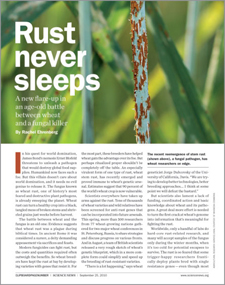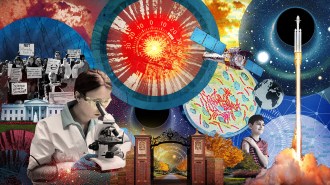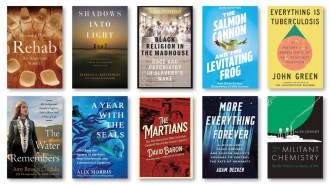90th Anniversary Issue: 1960s
The space race, technological optimism and other highlights, 1960–69
Race to the moon
Science News Letter did its best to downplay the Soviet Union’s achievement in launching Sputnik in 1957. “Our rocket scientists have been perfecting … their satellites, instead of concentrating upon scoring a ‘first,’ ” a reporter wrote that year (10/19/57, p. 243). Ongoing Russian victories became hard to swallow during the space race of the 1960s. When cosmonaut Yuri Gagarin became the first man in space, one politician said the United States needed “space enthusiasts who are willing to take some risks” (4/22/61, p. 243). The magazine also tracked celebrations, such as when the United States had “practically overtaken” the Soviet Union in 1965 (6/19/65, p. 387), and lamented setbacks like the deaths of three astronauts in 1967 (2/4/67, p. 112). Though predicted “moon mines” and “space factories” never became a reality, the American flag planted on the moon in 1969 became a banner for a U.S. space program that still makes headlines today. — Devin Powell

Note: N indicates findings that went on to win a Nobel Prize.
1960 | Laser Theodore Maiman demonstrates the first optical maser, or laser (4/23/60, p. 259).
1960 | Marrow transplant Physicians report successfully transplanting bone marrow from one woman to another with Hodgkin’s-like disease (1/23/60, p. 54).
1961 | Cosmonaut Yuri Gagarin of the Soviet Union becomes the first human to orbit the Earth (4/22/61, p. 243).
1963 | Cancer screening Mammography is shown to be a valuable gauge of the presence of breast tumors (3/23/63, p. 184).
1963 | EM pulse Military tests show that a high-altitude atomic bomb detonation could unleash a broad electromagnetic pulse that would disrupt all electronics (11/9/63, p. 293).
1964 | Quarks Murray Gell-Mann and George Zweig independently propose the existence of quarks — fractionally charged particles within protons and neutrons (4/25/64, p. 261). N
1964 | Quasars Astronomers describe 12 strange celestial objects that appear sometimes starlike and sometimes galaxy-like as quasars, for quasi-stellar objects (5/9/64, p. 297).
1965 | Antibiotic resistance Doctors report that Staphylococcus bacteria are becoming resistant to antibiotics (1/30/65, p. 69).
1966 | Moon landing The Soviet Luna 9 spacecraft makes the first soft landing on the moon (2/19/66, p. 114).
1967 | Heart transplant Christiaan Barnard in Cape Town, South Africa, transplants a human heart into Louis Washkansky (12/16/67, p. 581; 1/6/68, p. 8).
1967 | Pulsar The first pulsar — stellar objects emitting beams of radiation that look from Earth like pulses — is discovered (3/16/68, p. 255; 8/3/68, p. 114; 10/12/68, p. 362). N
1969 | Man on moon Apollo 11 astronauts Neil Armstrong and Buzz Aldrin walk on the moon (7/26/69, p. 71, 72, 75).
1969 | In vitro fertilization Scientists report for the first time test-tube fertilization (shown above) of human eggs (3/1/69, p. 209). N
The future’s so bright
The science writing of the 1950s and ’60s reflected an Atomic Age optimism that technology could solve nearly any problem. Some of the ideas of the time foresaw a future that never quite came to fruition.
1957 Engineer Richard Whitcomb predicts that in 10 years, commercial planes “should be able to fly approximately 3,000 miles at about 1,000 miles per hour” (3/23/57, p. 179). In 1958, reports claim that “by 1966 at the latest, the air traveler will fly commercially from Los Angeles to New York in under two hours” (6/14/58, p. 378).
 1966 People could travel even faster through “mole-hole tunnels,” moving between any two cities in 42 minutes by essentially “falling” through a frictionless tube to the new locale, a Sylvania Electronic Systems scientist calculates (2/19/66, p. 117).
1966 People could travel even faster through “mole-hole tunnels,” moving between any two cities in 42 minutes by essentially “falling” through a frictionless tube to the new locale, a Sylvania Electronic Systems scientist calculates (2/19/66, p. 117).
1955 “Atomic plants do not pose the ‘disposal’ problem that many laymen often think.… Fifty years would perhaps be the right time to let the hottest radiations die away” (8/27/55, p. 131).
1958 Scientists suggest they have “outguessed rust diseases that could attack wheat for the next 100 years” (5/31/58, p. 341). Science News still has coverage (above) of these pernicious fungi (9/25/10, p. 22). —Erika Engelhaupt







